|

|
|

|
|
15th Century European Hand Gun Fitted with sprung serpentine lock,
tapered 26" barrel, catalogue No. 2/03. This particular weapon has been featured in the excellent book:- |
|
POWDER
AND BALL SMALL ARMS |
|
by Martin Pegler, Senior Curator at the Royal Armouries Museum, Leeds. We would like to thank
the author and publishers The Crowood
Press Ltd, for their kind permission for the use of the following extract from the
book.
|
|
|
|
|
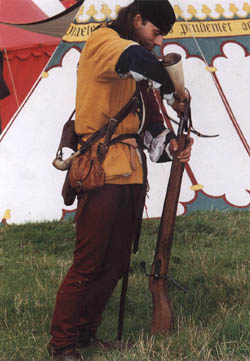 A
mercenary hand-gunner of c.1470 begins the long process of loading his
"first generation" matchlock. He uses his powder horn to
pour a charge of course powder, measured by eye and experience - early
flasks had no cut-off in the nozzle to isolate a predetermined charge.
The simple swivel serpentine trigger bar and match holder can be seen
clearly. A
mercenary hand-gunner of c.1470 begins the long process of loading his
"first generation" matchlock. He uses his powder horn to
pour a charge of course powder, measured by eye and experience - early
flasks had no cut-off in the nozzle to isolate a predetermined charge.
The simple swivel serpentine trigger bar and match holder can be seen
clearly.
|
|
|
|
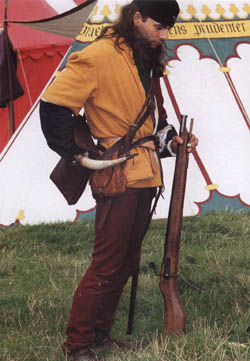 He
reaches into his bullet bag for a lead ball, which he drops into the
barrel. No wadding was used on this occasion. He
reaches into his bullet bag for a lead ball, which he drops into the
barrel. No wadding was used on this occasion.
|
|
|
|
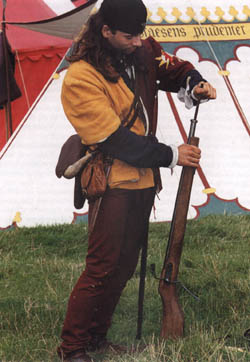 Ramming
the ball home with his wooden ramrod. If speed were essential he would
most likely have used a 'rolling ball' for the first few shots of an
engagement - simply letting the ball drop into the barrel and seating it by
banging the butt smartly against the ground. The gross fouling of the
barrel would probably prevent this after half a dozen shots. Ramming
the ball home with his wooden ramrod. If speed were essential he would
most likely have used a 'rolling ball' for the first few shots of an
engagement - simply letting the ball drop into the barrel and seating it by
banging the butt smartly against the ground. The gross fouling of the
barrel would probably prevent this after half a dozen shots.
|
|
|
|
 Using
a simple pricker to ensure the touch hole is clear of debris. This
simple but vital tool was ideally made from a sharp piece of wire - brass,
so as to avoid sparks. Using
a simple pricker to ensure the touch hole is clear of debris. This
simple but vital tool was ideally made from a sharp piece of wire - brass,
so as to avoid sparks.
|
|
|
|
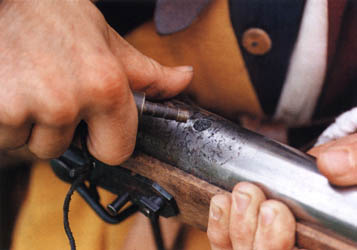 The
comparatively shallow priming recess is visible on top of the breech.
Trying to fill it with a fine powder in high a wind was a challenging
experience. The
comparatively shallow priming recess is visible on top of the breech.
Trying to fill it with a fine powder in high a wind was a challenging
experience.
|
|
|
 Clamping
the matchcord in the jaws of the serpentine; ensuring it is exactly the
right length to drop into the priming takes practice. If there is a
delay between this step and firing, the smouldering end of the cord may
accumulate ash which cools the tip and preventing it igniting the priming
powder - but blowing on the tip to keep it glowing risks blowing the priming
out of it's open recess... This is modern matchcord, medieval cord
being coarser in texture. Clamping
the matchcord in the jaws of the serpentine; ensuring it is exactly the
right length to drop into the priming takes practice. If there is a
delay between this step and firing, the smouldering end of the cord may
accumulate ash which cools the tip and preventing it igniting the priming
powder - but blowing on the tip to keep it glowing risks blowing the priming
out of it's open recess... This is modern matchcord, medieval cord
being coarser in texture.
|
|
|
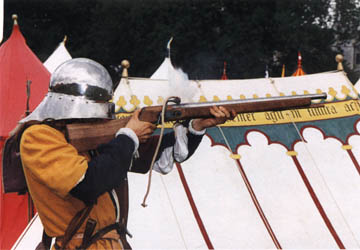 ignition
- the first flare of the priming is just visible against the tent in the
background. The gunner would usually have the loose end of the length
of match wrapped around his left hand, because a frequent result of firing
was having the match blown out of the jaws of the serpentine - ignition
- the first flare of the priming is just visible against the tent in the
background. The gunner would usually have the loose end of the length
of match wrapped around his left hand, because a frequent result of firing
was having the match blown out of the jaws of the serpentine - |
|
|
|
 as
is happening in this picture. as
is happening in this picture.
|
|
|
|
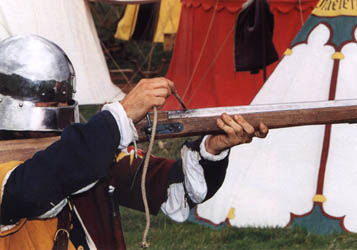 The
alternative method of firing was simply to ignore the serpentine and hold
the match to the priming powder. It seems likely that this was often
done in the heat of battle. The
alternative method of firing was simply to ignore the serpentine and hold
the match to the priming powder. It seems likely that this was often
done in the heat of battle.
|
|
|
 The
publication from which the above were taken is:- The
publication from which the above were taken is:-
LIVE
FIRING CLASSIC MILITARY WEAPONS IN COLOUR PHOTOGRAPHS POWDER
AND BALL SMALL ARMS Written
by: Martin Pegler ISBN 1 86126 185 3 Price
£25.00 + £2.50 - postage & packing Published
by: The Crowood Press Ltd
Ramsbury
Marlborough
Wiltshire
SN8 2HR
England Telephone: +44 (0)1672 520320
Fax: +44
(0)1672 520280 |
|
|
|
|
|

The
Crowood Press
www.crowood.com
E-mail: enquiries@crowood.com
|
|
All images except for the ASA logos, catalogue photograph and stock
diagram are copyright of The Crowood Press Ltd, as is the text describing
their contents. Everything else being copyright of Albion Small
Arms. Please respect the copyright ownership and refrain
from copying these items.
|
|
|
|